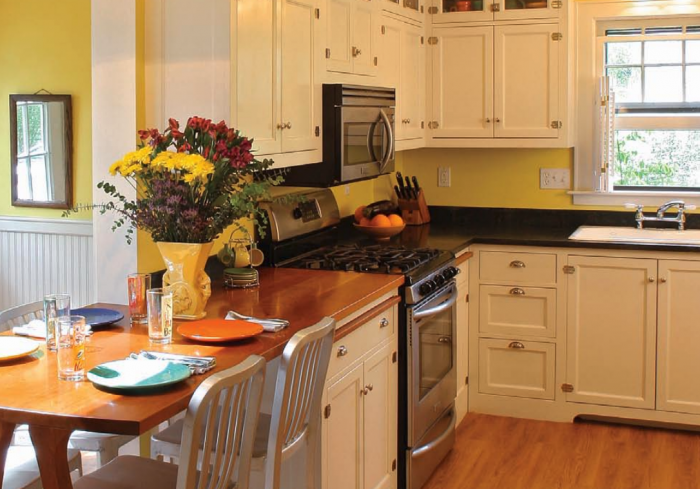Recirculating Hoods and Indoor-Air Quality
Recirculating hoods work as part of a system to move pollutants in the air further away from the breathing zone.

A few years ago, Fine Homebuilding published a very energy-efficient house that had a recirculating range hood. The reason for the recirculating hood was to avoid punching an additional hole in the air barrier and to avoid the need for makeup air, if my memory serves me. Now I’m faced with a similar decision. Seems recirculating hoods won’t remove moisture from the kitchen—do they at least do an adequate job of filtering the air?
—Karen Dorsel, Lincoln, Neb.
Building science expert Kristof Irwin replies: The short answer is no. Recirculating hoods neither remove moisture from the air, nor do an adequate job of filtering. The reason the answer is no is because recirculating hoods only endeavor to move the air further away from the breathing zone near the range to reduce the smoke/odor in that area. The filters mainly aim to capture grease so less of it hits your forehead when you cook. Some filters also use activated charcoal as a way to capture some of the chemical compounds released when cooking. In neither case are particles or moisture removed from the air.
A slightly more detailed answer starts with a couple of facts. The first is that cooking is chemistry and cooking effluents are indoor-air- quality pollutants. The second is that the building science perspective that originally motivated the use of recirculating range hoods has evolved. Let’s explore each of these briefly.
Understanding cooking effluents and pollutants
The term pollutants means that what is released into the air from cooking negatively impacts the air quality in terms of our respiratory health. If there was no negative health impact, we would just call them substances. Based on the work of the researchers at LBL and others, including the HOMEChem research here at the University of Texas at Austin, we now know that cooking indoors can have significant negative effects on our health. Please refer to those links for more detail as there is a lot more to the story.
As an entry into the evolving nature of building-science recommendations, consider the tagline here at Positive Energy: “Design around people, a good building follows” (credit to Robert Bean). The message being that in addition to focusing on outcomes of energy efficiency and durability, it is also important to think about direct impacts to human health and well being. The motivation for restricting the number of holes in a building’s air-control layer were associated with energy efficiency and durability. When we take health into account the answer shifts.
Viewing hoods as part of a system
A core issue here is faulty thinking about what a hood is and does. A hood is only part of a system. The functional role of the hood part of the system is to capture pollutants from cooking and exhaust them out of the breathing zone inside the home. Clearly a recirculating hood fails at this. Even when a hood exhausts to the exterior, it will not work properly unless building science and system thinking is applied. When seen as a system it becomes clear that, as we build increasingly well-air-sealed enclosures, we need to provide incoming airflow to make up for any air that we send out of the home using a fan. This makeup-air issue foreshadows a reality that many of us see on the near horizon—any powered device that intentionally moves air from inside a home to outside needs integrated makeup air. Together the exhaust hood, fan, ducting, and makeup air form a functional system.
Getting back to your decision, the short answer to the question, “what do I do about my range hood,” is to vent it to the exterior and provide makeup air. The slightly more detailed answer has a few key points, including:
- Reduce the amount of cooking effluent (AKA pollutants) you create by using a lid and limiting the amount of high-temperature oil cooking you do indoors.
- Increase the capture efficiency of the hood by making sure it has a deep sump. Without an effective capture geometry, the pollutants just spill out around the hood. Think square tires to get a sense of how silly it is to design a hood that’s flat at the bottom.
- Move the right amount of air and the right speed to maintain pollutant entrainment in the air stream.
- Make sure to use metal ducting that has a path to the exterior that is as short as possible with a minimum number of bends.
- Finally, use the hood and turn it on whenever you cook.
The performance of your range hood impacts your health. It’s worth doing it right.
Photo: Charles Miller
RELATED LINKS





























